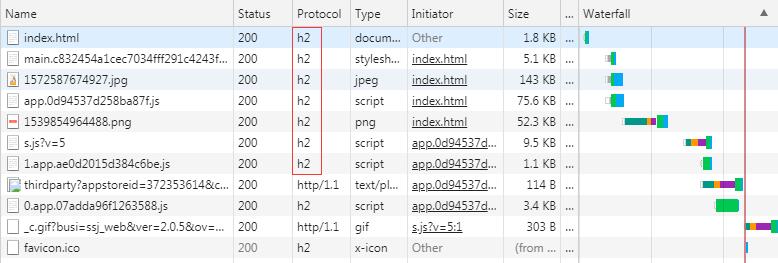1. Preface
Recently, we are optimizing the visiting speed of the website and opening http2 protocol for the website. What are the advantages of this protocol? As follows:
-
http2 is the next generation transport protocol, which will be widely used in the future, which is a trend.
-
http2 has the feature of multiplexing, which means to access resources under a domain name, and multiple requests share a TCP link, so it is much faster than http1.1.
2. Preparations
-
It is necessary to recompile openssl version 1.0.2 or above, because our system version is all centos6, which does not support update openssl directly from yum. If it is centos7, update it directly from yum update openssl -y
-
After compiling openssl, we need to recompile Tenginx using the openssl library file. The Tengine version we used is Tengine/2.2.2.
3. Operation steps
- Install openssl-1.0.2t
#Enter / usr/local/src, and the general software package will be put here cd /usr/local/src #Download the installation package wget https://www.openssl.org/source/openssl-1.0.2t.tar.gz tar -zxvf openssl-1.0.2t.tar.gz cd openssl-1.0.2t ./config shared zlib #Default install to / usr/local/ssl make && make install #Back up the previous version first mv /usr/bin/openssl /usr/bin/openssl.old mv /usr/include/openssl /usr/include/openssl.old #Establish a soft connection ln -s /usr/local/ssl/bin/openssl /usr/bin/openssl ln -s /usr/local/ssl/include/openssl /usr/include/openssl #Add dynamic library to system configuration path echo "/usr/local/ssl/lib" >> /etc/ld.so.conf #Check whether the dynamic library is effective ldconfig -p #Check openssl version openssl version
- Install Tenginx
cd /usr/local/src wget http://tengine.taobao.org/download/tengine-2.2.2.tar.gz tar tengine-2.2.2.tar.gz cd tengine-2.2.2 #The tengine code needs to be modified here. Because we are manually compiling openssl, the path of the dependency library is not the same as that of the original system installation, so we need to specify it manually vim auto/lib/openssl/conf #In about 32 lines, the original configuration is as follows: CORE_INCS="$CORE_INCS $OPENSSL/.openssl/include" CORE_DEPS="$CORE_DEPS $OPENSSL/.openssl/include/openssl/ssl.h" CORE_LIBS="$CORE_LIBS $OPENSSL/.openssl/lib/libssl.a" CORE_LIBS="$CORE_LIBS $OPENSSL/.openssl/lib/libcrypto.a" #Modify as follows, save and exit CORE_INCS="$CORE_INCS $OPENSSL/include" CORE_DEPS="$CORE_DEPS $OPENSSL/include/openssl/ssl.h" CORE_LIBS="$CORE_LIBS $OPENSSL/lib/libssl.a" CORE_LIBS="$CORE_LIBS $OPENSSL/lib/libcrypto.a" #Install some dependencies first (I'm upgrading, actually I don't need to install dependencies. If I install tenginx for the first time, I need to install dependencies) yum -y install zlib zlib-devel openssl openssl-devel pcre pcre-devel gcc gcc-c++ autoconf automake jemalloc jemalloc-devel #Begin compiling tenginx cd /usr/local/src/tengine-2.2.2 && ./configure --prefix=/usr/local/nginx --with-http_stub_status_module --with-http_ssl_module --with-http_gzip_static_module --with-http_concat_module --with-jemalloc --with-http_v2_module --with-http_secure_link_module --with-openssl=/usr/local/ssl make ##Note that if you are installing teginx first, you only need to execute the following command make install #But I have installed it, so I need to back up the old tenginx cp -af /usr/local/nginx/sbin/nginx /usr/local/nginx/sbin/nginx_bak cp -af /usr/local/nginx/sbin/dso_tool /usr/local/nginx/sbin/dso_tool_bak #Copy the compiled tenginx to the corresponding directory cp /usr/local/src/tengine-2.2.2/objs/nginx /usr/local/nginx/sbin/ cp /usr/local/src/tengine-2.2.2/objs/dso_tool /usr/local/nginx/sbin/ #Then restart Tenginx, even if the compilation and installation are completed
- Tenginx http2 configuration
#Configuring http2 is simple, as follows: server { #HTTP does not support the transport protocol of http2, so port 80 does not change listen 80 # listen add http2 based on the original https configuration file listen 443 ssl http2; server_name www.oneq.work; ..... } #In addition, a complete Tenginx configuration supporting http2 is attached upstream server_backend { server ip:80 weight=10; server ip:80 weight=10; keepalive 800; #The configuration of the following detection port needs Tenginx to be effective. It's not that Tenginx needs to install additional plug-ins or direct comments check interval=5000 rise=3 fall=3 timeout=5000 type=tcp; } server { listen 80; listen 443 ssl http2; server_name xxx.xxx.xxx; req_status server; ssl_certificate /usr/local/nginx/certs/xxx.xxx.xxx.crt; ssl_certificate_key /usr/local/nginx/certs/xxx.xxx.xxx.key; ssl_session_timeout 5m; ssl_protocols TLSv1.1 TLSv1.2 TLSv1; ssl_ciphers HIGH:!aNULL:!MD5; ssl_prefer_server_ciphers on; proxy_set_header Host $host; proxy_set_header X-Real-IP $remote_addr; proxy_set_header X-Forwarded-For $proxy_add_x_forwarded_for; proxy_pass_header User-Agent; proxy_set_header X-Forwarded-Proto $scheme; proxy_set_header Connection ""; proxy_http_version 1.1; access_log logs/access.log main; location / { proxy_pass http://server_backend/; access_log logs/server_backend.log main; } error_page 404 /404.html; location = /404.html { root html; } error_page 500 502 503 504 /50x.html; location = /50x.html { root html; } }
4. Effect display

5. summary
1. There are some differences between the first installation of tenginx and the upgrade steps. Please pay attention to the following
2.http does not support the transport protocol of http2, so port 80 still uses the protocol of http1.1, and https uses the transport protocol of http2
>Author blog Qingye's blog